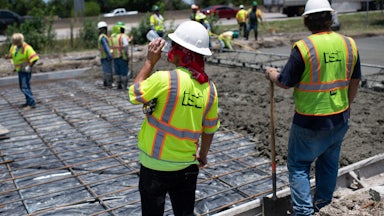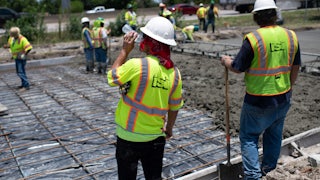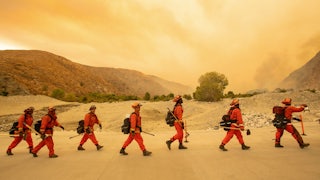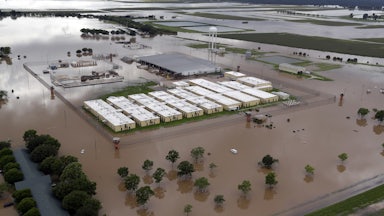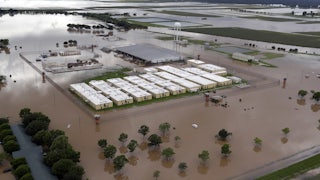Debra Schlegel, a 64-year-old who used a wheelchair, and Tommy “TJ” McCullough, a 35-year-old, are just two of the at least nine people who died in Texas prisons in the midst of a heat wave in recent weeks. McCullough died after working outside, mowing a field, on a day when the heat index rose to 105 degrees. Despite reports from people inside the prisons about sweltering temperatures, neither death has been acknowledged by the Texas Department of Criminal Justice as heat-related.
When I reached out to ask TDCJ about the deaths of these people, communications director Amanda Hernandez said that Texas prisons have had no heat deaths since 2012. Shlegel died in air conditioning and had preexisting medical conditions, Hernandez told me in an email, and the Office of the Inspector General is investigating her death. TDCJ said it is waiting for the results of McCullough’s autopsy; Hernandez said that the agency “take[s] numerous precautions to lessen the effects of hot temperatures for those incarcerated within our facilities.”
Marci Marie Simmons, a community outreach coordinator with Lioness, an Austin-based group that supports women impacted by incarceration, doesn’t believe the agency’s claims. Until 2021, Simmons was incarcerated at the same unit as Schlegel, a unit called Lane Murray. She remains in contact with women inside, who Simmons said suspect that the 64-year-old’s death was heat-related, even if she ultimately died in an air-conditioned medical area.
Much of Lane Murray is not air-conditioned, and the facility’s layout means that women frequently have to walk outside in between dorms, Simmons noted.
“You are not allowed to assist someone in a wheelchair,” she said. “I have very clear images during summertime of women—especially older ladies—trying to get back from chow. You can just imagine being out in 100 degree weather, and trying to push yourself in a wheelchair.”
Every summer, people die in brutal heat in Texas prisons without air conditioning. Most of the time, the officials charged with taking care of them record their passing with no mention of the temperature. The link between heat and death survives only with family and fellow prisoners.
This summer, however, organizing led by loved ones of incarcerated people is reaching a crescendo, and the alarms coming from media and public officials about Texas’s uncounted prison heat deaths are louder than I’ve seen in three years of covering this issue closely. The question is whether this activism will translate into changes that protect people—in Texas and nationwide.
Despite the region’s sweltering temperatures that are only getting hotter as the climate continues to change, more than two-thirds of Texas prisons lack air conditioning in most dormitories. Temperatures on the inside on hot summer days have been recorded as high as 149 degrees. Protocols designed to protect prisoners from heat—including requirements for air-conditioned respite, identification of heat-sensitive prisoners, and access to water—were put in place only in the past decade, after several families sued TDCJ over the deaths of their loved ones. Simmons and other advocates told me that severe and well-documented staffing issues across TDCJ mean that the agency’s heat safety protocols are inconsistently carried out—and that they’re not enough to begin with.
But only last month, Texas senators killed a bill that would have established a prison temperature standard of 65 to 85 degrees, as well as funding of $545 million for the first two parts of a four-phase air-conditioning installation plan. Despite a $32.7 billion budget surplus this year, the legislature allocated no funds specifically for prison air conditioning. It was déjà vu after similar efforts failed in Texas’s last legislative session in 2021, when the House passed a prison cooling bill only for the Senate to let it die.
Now, advocates’ sights are on getting air-conditioning funding considered at an upcoming special legislative session. Unfortunately, Republican Governor Greg Abbott sets the agenda for these sessions. As attorney general, Abbott fought against prison heat-related lawsuits, and as governor he signed a law in June ending mandatory water breaks for construction workers.
Amite Dominick, head of Texas Prisons Community Advocates, a grassroots group largely made up of the loved ones of people who are incarcerated, told me that temperature rules need to be made above Abbott’s head. “We need a federal mandate,” she said. “Biden does have the option to incentivize these prisons for incarceration rate reduction and setting some sort of standard.”
The truth is, no Texas policymaker has the power to do what it takes to fully address the prison heat deaths crisis—it extends far beyond the state’s borders. Although no state rivals Texas when it comes to organizing around heat and prison deaths, organizers and researchers in other states are beginning to demonstrate the urgency of the heat issue nationwide.
That heat-related deaths tend to be undercounted is not a problem particular to prisons. Heat can exacerbate an array of health problems and trigger health crises that are not often described as “hyperthermia,” the scientific term for overheating, by medical examiners. However, obfuscation intensifies in state-run facilities, where drawing a line between heat and death can lead to lawsuits. In prisons, a large number of people have health conditions that make them sensitive to heat, and everyone is wholly dependent on often-understaffed corrections departments to keep them safe.
It’s left to researchers, then, to look for spikes in deaths during periods of high heat. Last November, a study co-authored by Dominick from Texas Prisons Community Advocates and published in the journal JAMA Network Open found that extreme heat was likely behind 271 deaths in Texas prisons without air conditioning—about 13 percent of summer prison deaths between 2001 and 2019. The study’s lead author, Julie Skarha, followed up with a separate study looking at the rest of the country, and found that nationwide a 10 degree temperature rise above average was linked to a 5.2 percent increase in mortality among incarcerated people.
Surprisingly, she found the heat impact to be strongest in the Northeast, where a two-day heat wave correlated with a 21 percent increase in prison mortality—likely because people’s bodies and prison buildings are unprepared for heat. A report by the New Jersey Office of the Corrections Ombudsperson found 3,500 people living with no air conditioning in state prisons.
The Ombudsman offered an array of adjustments that New Jersey prison officials could put in place, from providing more ice to expanding the definition of “heat sensitive” people. Echoing what Texas organizers have been saying for years, it stressed that temperatures could only truly be controlled via a push from legislators for huge investments in prison cooling infrastructure.
With Texas still sweltering, another heat wave is sweeping across California, where temperatures are expected to spike above 100 degrees just in time for firework-fueled Independence Day. People in prisons and their loved ones are preparing to be hit hard by both heat and wildfire smoke.
In the Golden State, the media has paid particular attention to the threat of wildfires to prisoners—especially those working for minimal pay as firefighters. However, extreme heat was the climate hazard most widely experienced by participants in a survey conducted by researchers with the Ella Baker Center for Human Rights and published last month. (Disclosure: The report’s authors interviewed me about my prison climate risk mapping project.) Sixty percent of respondents said they had never accessed an air-conditioned room during periods of high heat. Meanwhile, 44 percent of those participants said they had feared for their life due to extreme heat, and 26 percent reported experiencing heat stroke.
The authors provided eight policy recommendations for state officials, with decarceration strategies at the top of the list. Decrease the prison population by 50,000 people; close prisons vulnerable to climate issues; and create rapid release policies for emergencies, the researchers advised. They pushed too for better emergency preparations, including expanded trainings and minimum standards for emergency plans, as well as more transparency via annual reports related to climate impacts on facilities. Despite California organizers’ hesitation to recommend new prison investments, the report did recommend reallocating the California Department of Corrections and Rehabilitation’s existing budget to pay for air conditioning, shade structures, and backup generators.
In Louisiana, where residents were also hit by the heat dome, the nonprofit Taproot Earth provided its own wide-ranging policy blueprint last month for surviving the climate crisis, with incarcerated people at its center. The report focused on the way that prisons are not only sites of intensified forms of climate-related suffering—they also drain systems for reducing disaster-related suffering in the wider community, leaving everyone worse-prepared for climate catastrophe. Rather than recommend infrastructure investments, the report centers strategies that avoid putting people in harm’s way to begin with.
“All environmentally vulnerable carceral facilities must be closed—and when a disaster strikes them, they must not be rebuilt or reopened,” the report states.
Although the White House Environmental Justice Advisory Council has recommended the Biden administration pay closer attention to the impact of the climate crisis on prisons, the federal government has not made significant moves toward addressing the heat issue. Hints exist, however, as to how that might be done. A few Republican-controlled Southern states, like Mississippi and Louisiana, that looked unlikely ever to make moves on prison air conditioning have begun to fund it over the past few years—some using federal Covid-relief funding. Mississippi’s Department of Corrections indicated that its effort on air conditioning was in part an attempt to relieve pressure from the U.S. Justice Department, which suggests that federal pressure could be a stick to convince reticent states to act. Congress could also try to pass legislation, but past efforts haven’t yet borne fruit; a prison climate disaster relief bill introduced by Senator Tammy Duckworth in 2020 has repeatedly failed to advance.
Regardless of the strategy, without multimillion-dollar infrastructure investments or a major shift away from mass incarceration, state and federal officials face a mounting death toll. An analysis by the nonprofit organization Climate Central’s Climate Shift Index found that the climate crisis made the heat wave in Texas five times more likely.
“The fact we’re seeing so many more triple-digit days—it’s making the issues glaring,” said Dominick.
And all the while, people inside are bearing the cost of inaction.
“I don’t know that there’s an accurate way to describe how oppressing that heat is at this time of the year,” Simmons told me. “I just remember counting down the days. Mentally having to tell myself, it’s the end of June—this month is almost over. I can get through July and August.”

